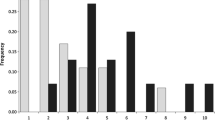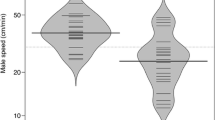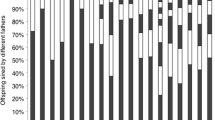Abstract
The common shrew (Sorex araneus) is a solitary small mammal with a promiscuous mating system. Previous studies of this species suggest that females typically mate multiply, and that males may adopt alternative mate-searching tactics. We studied two generations of common shrews in a population near Oxford, England. Males were found to adopt two different mate-searching tactics. Those classed as type A occupied relatively small exclusive ranges during March, and made repeated long-distance movements to visit female ranges around the time of first oestrus in April. Males classed as type B established large overlapping ranges in areas of relatively high female density during March, and maintained these ranges throughout April. Type B males were larger than type A males at an early stage of sexual maturation, but there was no difference in the adult body size of the two types of male. Type A males had significantly higher epididymal sperm counts than type B males. Paternity analyses of litters born during the first year of the study reveal that the mean number of offspring fathered by type B males was greater than the mean number fathered by type A males. It is concluded that different mate-searching tactics may be conditional upon the timing of sexual maturation. Differences in sperm production are discussed in relation to sperm competition theory.
Similar content being viewed by others
References
Alcock J, Jones CE, Buchman SL (1977) Male mating strategies in the bee Centris pallida Fox (Anthoporidae: Hymenoptera). Am Nat 111:145–155
Barnard CJ, Brown CAJ (1982) The effects of prior residence, competitive ability and food availability on the outcome of interactions between shrews (Sorer araneus L.). Behav Ecol Sociobiol 10:307–312
Bellis RR, Baker MA, Gage MJG (1990) Variation in rat ejaculates consistent with the kamikaze sperm hypothesis. J Mammal 71:479–480
Brambell FWR (1935) Reproduction in the common shrew Sorex araneus Linnaeus. Philos Trans R Soc London B 225:1–62
Buckner CH (1969) Some aspects of the population ecology of the common shrew Sorex araneus, near Oxford, England. J Mammal 50:326–332
Crowcroft P (1957) The life of the shrew. Reinhardt, London
Dawkins R (1979) Good strategy or evolutionarily stable strategy? In: Barlow GW, Silverberg J (eds) Sociobiology: beyond nature/nurture? Westview Press, Boulder Colorado, pp 331–367
Dewsbury DA (1982) Ejaculate cost and male choice. Am Nat 119:601–610
Dominey W (1984) Alternative mating tactics and evolutionary stable strategies. Am Zool 24:385–396
Dunbar RIM (1982) Intraspecific variations in mating strategy. In: Bateson PPG, Klopfer PH (eds) Perspectives in ethology, vol V. Plenum, New York, pp 385–431
Dunbar RIM, Dunbar P (1975) Social dynamics of gelada baboons (Contributions to primatology, vol 6). Karger, Basel
Eggert AK (1992) Alternative mate-finding tactics in burying beetles. Behav Ecol 3:243–254
Feinberg AP, Vogelstein B (1983) A technique for radiolabelling DNA restriction endonuclease fragments to high specific activity. Anal Biochem 132:6–13
Feinberg AP, Vogelstein B (1984) Addendum — a technique for radiolabelling DNA restriction endonuclease fragments to high specific activity. Anal Biochem 137:266–267
Galbraith DA, Boag PT, Gibbs HL, White BN (1991) Sizing bands on autoradiograms — a study of precision for scoring DNA fingerprints. Electrophoresis 12:210–220
Grocock CA, Clarke JA (1974) Photoperiodic control of testis activity in the vole, Microtus agrestis. J Reprod Fert 39:337–347
Huck UW, Banks EM (1979) Behavioural components of individual recognition in the collared lemming (Dicrostonyx groenlandicus). Behav Ecol Sociobiol 6:85–90
Huck UW, Lisk RD, Allison JC, Van Dongen CG (1986) Determinants of mating success in the golden hamster (Mesocricetus auratus): social dominance and mating tactics under seminatural conditions. Anim Behav 34:971–989
Jeffreys AJ, Wilson V, Thein SL (1985) Hypervariable ‘minisatell-ite’ regions in human DNA. Nature 314:67–73
Kenagy GJ, Trombulak SC (1986) Size and function of mammalian testes in relation to body size. J Mammal 67:1–22
Koprowski JL (1993) Alternative reproductive tactics in male eastern gray squirrels: “making the best of a bad job”. Behav Ecol 4:165–171
Little JL, Gurnell J (1989) Shrew captures and rodent field studies. J Zool London 218:329–331
Mercer S, Searle JB. Maintenance of the common shrew, Sorex araneus: breeding, hybridisation and maturation in captivity. J Mammal (in press)
Michielsen NC (1966) Intraspecific and interspecific competition in the shrews Sorex araneus L. and Sorex minutus L. Arch Néerl Zool 17:73–174
Parker GA (1970) Sperm competition and its evolutionary consequences in the insects. Biol Rev 45:525–567
Parker GA (1990a) Sperm competition games: raffles and roles. Proc R Soc London B 242:120–126
Parker GA (1990b) Sperm competition games: guards and extra pair copulations. Proc R Soc London B 242:127–133
Pucek Z (1970) Seasonal and age changes in shrews as an adaptive process. Symp Zool Soc London 26:189–207
Randall JA (1991) Mating strategies of a nocturnal, desert rodent (Dipodomys spectabilis). Behav Ecol Sociobiol 28:215–220
Raw A (1976) The behaviour of males of the solitary bee Osmia rufa (Megachilidae) searching for females. Behaviour 56:279–285
Rubenstein DI (1980) On the evolution of alternative mating strategies. In: Staddon JER (ed) Limits to action: the allocation of individual behaviour. Academic Press, New York, pp 65–100
Schwagmeyer PL (1988) Scramble competition polygyny in an asocial mammal: male mobility and mating success. Am Nat 131:885–892
Schwagmeyer PL, Parker GA (1987) Queuing for mates in thirteen-lined ground squirrels. Anim Behav 35:1015–1025
Searle AG, Beechey CV (1974) Sperm-count, egg fertilization and dominant lethality after X-irradiation of mice. Mut Res 22:63–72
Searle JB (1984a) Breeding the common shrew (Sorex araneus) in captivity. Lab Anim 18:359–363
Searle JB (1984b) Nondisjunction frequency in Robertsonian heterozygotes from natural populations of the common shrew, Sorex araneus L. Cytogenet Cell Genet 38:265–271
Searle JB (1990) Evidence for multiple paternity in the common shrew (Sorex araneus). J Mammal 71:139–144
Shillito JF (1963) Observations on the range and movements of a woodland population of the common shrew, Sorex araneus L. Proc Zool Soc London 140:533–546
Southern EM (1975) Detection of specific sequence among DNA fragments separated by gel electrophoresis. J Mol Biol 98:503–517
Stockley P (1992) The mating system of the common shrew. D Phil thesis, University of Oxford
Stockley P, Searle JB, Macdonald DW, Jones CS (1993) Female multiple mating behaviour in the common shrew as a strategy to reduce inbreeding. Proc R Soc London 254:173–179
Tegelström H, Searle JB, Brookfield J, Mercer S (1991) Multiple paternity in wild common shrews (Sorex araneus) in confirmed by DNA fingerprinting. Heredity 66:373–379
Wells KD (1977) The social behaviour of anuran amphibians. Anim Behav 25:666–693
Westneat DF (1990) Genetic parentage in the indigo bunting: a study using DNA fingerprinting. Behav Ecol Sociobiol 27:67–76
Wetton JH, Carter RE, Parkin DT, Walters D (1987) Demographic study of a wild house sparrow population by DNA fingerprinting. Nature 327:147–149
Author information
Authors and Affiliations
Rights and permissions
About this article
Cite this article
Stockley, P., Searle, J.B., Macdonald, D.W. et al. Alternative reproductive tactics in male common shrews: relationships between mate-searching behaviour, sperm production, and reproductive success as revealed by DNA fingerprinting. Behav Ecol Sociobiol 34, 71–78 (1994). https://doi.org/10.1007/BF00175460
Received:
Accepted:
Issue Date:
DOI: https://doi.org/10.1007/BF00175460




